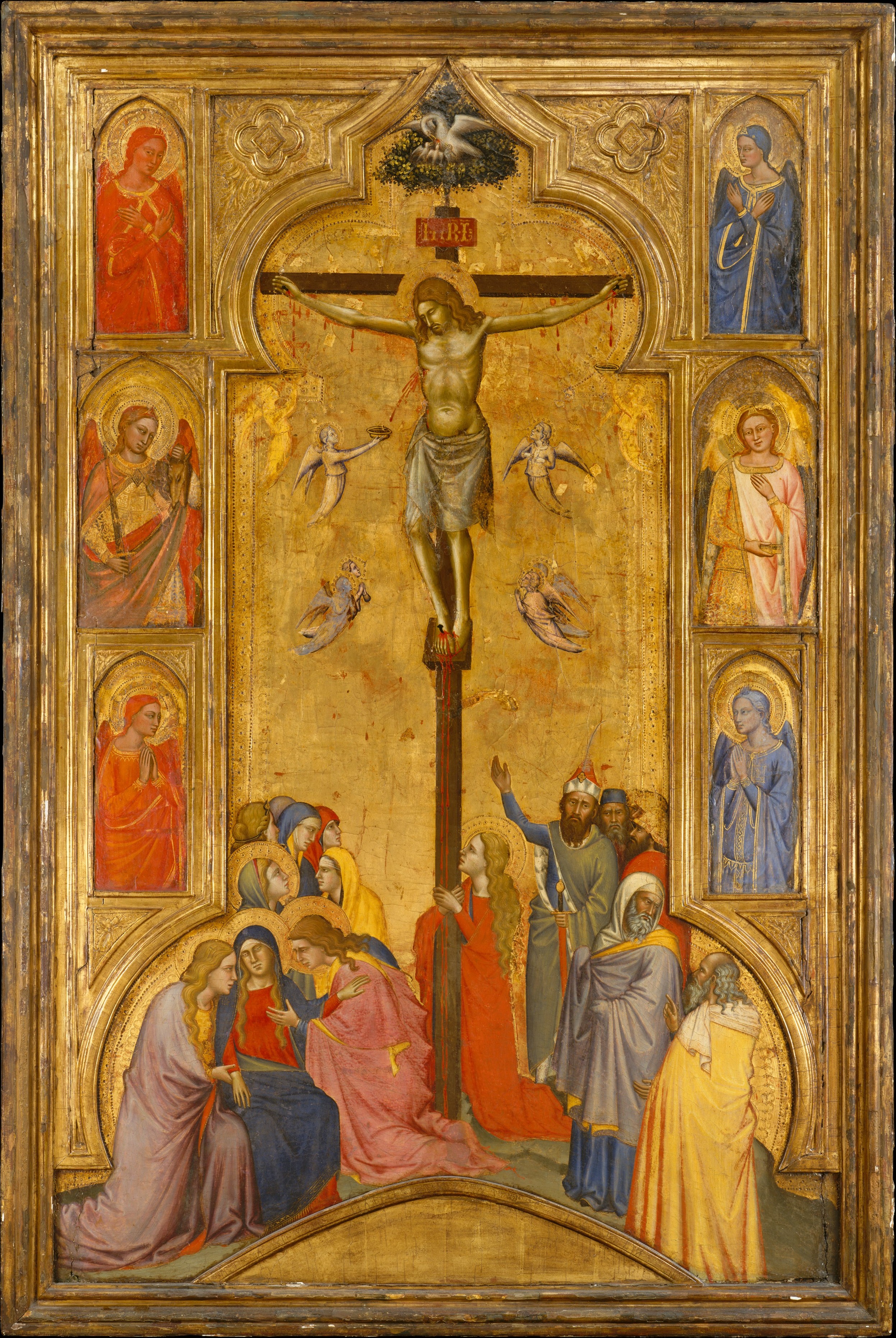|
The Wilton Diptych (Right)
The Wilton Diptych () is a small portable diptych of two hinged panels, painted on both sides, now in the National Gallery, London. It is an extremely rare survival of a late medieval religious panel painting from England. The diptych was painted for King Richard II of England, who is depicted kneeling before the Virgin and Child in what is known as a donor portrait. He is presented to them by (left to right) the English saints King Edmund the Martyr, King Edward the Confessor and patron saint, John the Baptist. The painting is an outstanding example of the International Gothic style, and the nationality of the unknown artist is probably French or English. Description The Wilton Diptych is painted on two panels of Baltic oak, set in frames of the same material and joined by two hinges so that it may be closed to protect the inner painting. The inner faces of the panels are in excellent condition for their age, though some glazes have been lost, but the outer faces have ... [...More Info...] [...Related Items...] OR: [Wikipedia] [Google] [Baidu] |
Diptych
A diptych (; from the Greek δίπτυχον, ''di'' "two" + '' ptychē'' "fold") is any object with two flat plates which form a pair, often attached by hinge. For example, the standard notebook and school exercise book of the ancient world was a diptych consisting of a pair of such plates that contained a recessed space filled with wax. Writing was accomplished by scratching the wax surface with a stylus. When the notes were no longer needed, the wax could be slightly heated and then smoothed to allow reuse. Ordinary versions had wooden frames, but more luxurious diptychs were crafted with more expensive materials. Art ] As an art term a diptych is an artwork consisting of two pieces or panels, that together create a singular art piece these can be attached together or presented adjoining each other. In medieval times, panels were often hinged so that they could be closed and the artworks protected. In Late Antiquity, ivory notebook diptychs with covers carved in low relie ... [...More Info...] [...Related Items...] OR: [Wikipedia] [Google] [Baidu] |
Gold Ground
Gold ground (both a noun and adjective) or gold-ground (adjective) is a term in art history for a style of images with all or most of the background in a solid gold colour. Historically, real gold leaf has normally been used, giving a luxurious appearance. The style has been used in several periods and places, but is especially associated with Byzantine and medieval art in mosaic, illuminated manuscripts and panel paintings, where it was for many centuries the dominant style for some types of images, such as icons. For three-dimensional objects, the term is gilded or gold-plated. Gold in mosaic began in Roman mosaics around the 1st century AD, and originally was used for details and had no particular religious connotation, but in Early Christian art it came to be regarded as very suitable for representing Christian religious figures, highlighting them against a plain but glistering background that might be read as representing heaven, or a less specific spiritual plane. Full- ... [...More Info...] [...Related Items...] OR: [Wikipedia] [Google] [Baidu] |
Livery Badge
A heraldic badge, emblem, impresa, device, or personal device worn as a badge indicates allegiance to, or the property of, an individual, family or corporate body. Medieval forms are usually called a livery badge, and also a cognizance. They are para-heraldic, not necessarily using elements from the coat of arms of the person or family they represent, though many do, often taking the crest or supporters. Their use is more flexible than that of arms proper. Badges worn on clothing were common in the late Middle Ages, particularly in England. They could be made of base metal, cloth or other materials and worn on the clothing of the followers of the person in question; grander forms would be worn by important persons, with the Dunstable Swan Jewel in enamelled gold a rare survivor. Livery collars were also given to important persons, often with the badge as a pendant. The badge would also be embroidered or appliqued on standards, horse trappings, livery uniforms, and other belongi ... [...More Info...] [...Related Items...] OR: [Wikipedia] [Google] [Baidu] |
The Burlington Magazine
''The Burlington Magazine'' is a monthly publication that covers the fine and decorative arts of all periods. Established in 1903, it is the longest running art journal in the English language. It has been published by a charitable organisation since 1986. History The magazine was established in 1903 by a group of art historians and connoisseurs which included Roger Fry, Herbert Horne, Bernard Berenson, and Charles Holmes. Its most esteemed editors have been Roger Fry (1909–1919), Herbert Read (1933–1939), and Benedict Nicolson (1948–1978). The journal's structure was loosely based on its contemporary British publication '' The Connoisseur'', which was mainly aimed at collectors and had firm connections with the art trade. ''The Burlington Magazine'', however, added to this late Victorian tradition of market-based criticism new elements of historical research inspired by the leading academic German periodicals and thus created a formula that has remained almost intact to ... [...More Info...] [...Related Items...] OR: [Wikipedia] [Google] [Baidu] |



